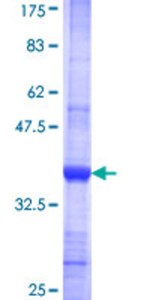Learn More
Abnova™ Human CRYBA4 Partial ORF (NP_001877, 96 a.a. - 195 a.a.) Recombinant Protein with GST-tag at N-terminal
Beschreibung
Crystallins are separated into two classes: taxon-specific, or enzyme, and ubiquitous. The latter class constitutes the major proteins of vertebrate eye lens and maintains the transparency and refractive index of the lens. Since lens central fiber cells lose their nuclei during development, these crystallins are made and then retained throughout life, making them extremely stable proteins. Mammalian lens crystallins are divided into alpha, beta, and gamma families; beta and gamma crystallins are also considered as a superfamily. Alpha and beta families are further divided into acidic and basic groups. Seven protein regions exist in crystallins: four homologous motifs, a connecting peptide, and N- and C-terminal extensions. Beta-crystallins, the most heterogeneous, differ by the presence of the C-terminal extension (present in the basic group, none in the acidic group). Beta-crystallins form aggregates of different sizes and are able to self-associate to form dimers or to form heterodimers with other beta-crystallins. This gene, a beta acidic group member, is part of a gene cluster with beta-B1, beta-B2, and beta-B3. [provided by RefSeq]
Spezifikation
Spezifikation
| Zugriffsnummer | NP_001877 |
| Zur Verwendung mit (Anwendung) | Antibody Production, ELISA, Protein Array, Western Blot |
| Zusammensetzung | 50mM Tris-HCI, 10mM reduced Glutathione, pH=8.0 in the elution buffer. |
| Gen-ID (Entrez) | 1413 |
| Molekulargewicht | 36.74kDa |
| Name | CRYBA4 (Human) Recombinant Protein (Q01) |
| Qualitätskontrollen | 12.5% SDS-PAGE Stained with Coomassie Blue. |
| Menge | 25 ug |
| Immunogen | PAACANHRDSRLTIFEQENFLGKKGELSDDYPSLQAMGWEGNEVGSFHVHSGAWVCSQFPGYRGFQYVLECDHHSGDYKHFREWGSHAPTFQVQSIRRIQ |
| Lagerungsbedingungen | Store at -80°C. Aliquot to avoid repeated freezing and thawing. |
| Mehr anzeigen |
Bitte geben Sie uns Ihr Feedback zu den Produktinhalten, indem Sie das folgende Formular ausfüllen.




